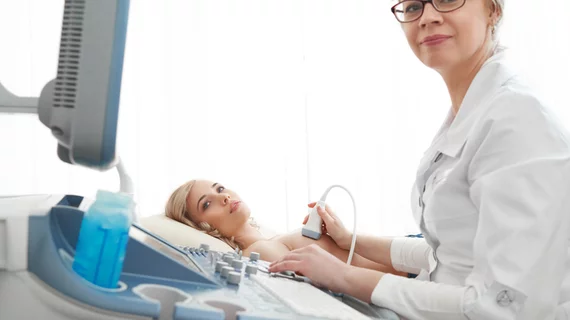Supplemental ultrasound screening paired with mammography can potentially improve cancer detection across all breast types, according to new research published in JAMA Network Open.
The go-to modality for this disease has been shown to reduce deaths, but mammography’s sensitivity plummets for those with dense tissue. Ultrasound, however, is showing promise improving those rates, Japanese researchers reported Aug. 18. The findings were derived from a secondary analysis of a randomized control trial incorporating more than 19,000 women.
“Adjunctive ultrasonography had good screening balance with mammography regardless of breast density, detecting early stage and invasive malignant lesions for asymptomatic women with average risk of breast cancer,” Narumi Harada-Shoji, MD, PhD, with the Department of Breast and Endocrine Surgical Oncology at Tohoku University in Sendai, Japan, and co-authors concluded. “Thus, adjunctive ultrasonography should be considered as an optimal solution in young women with average risk.”
For the study, scientists utilized data from the Japan Strategic Anti-Cancer Randomized Trial, incorporating asymptomatic women in their 40s screened between 2007 to 2020. Participants were randomly assigned to undergo either mammography with ultrasound (9,705 women) or mammo alone (9,508 more). Nearly 11,400 (or 59%) had heterogeneously or extremely dense breasts, and providers detected 130 cancers among the overall group.
Harada-Shoji et al. discovered significantly higher sensitivity in the intervention group (93%) when compared to those screened solely with mammography (67%). They observed similar numbers for women with dense breasts (93% vs. 71%) and nondense tissue (93% vs. 61%). The rate of interval cancers per 1,000 screenings was also lower in the ultrasound-mammography cohort (0.5 cancers) than mammography alone (2). And ultrasonography alone picked up significantly more invasive cancer cases among those with dense breasts (82% vs. 42%) along with nondense breasts (86% vs. 25%).
However, the sensitivity of mammography or ultrasonography alone never exceeded 80% across all breast densities in the two study groups, Harada-Shoji and co-authors noted. Specificity was also significantly lower in the intervention group, and both biopsy and recall rates were much higher.
“Taking these results into account, we can conclude that breast density should not be the sole criterion for deciding whether supplemental imaging is justified,” the authors advised.

